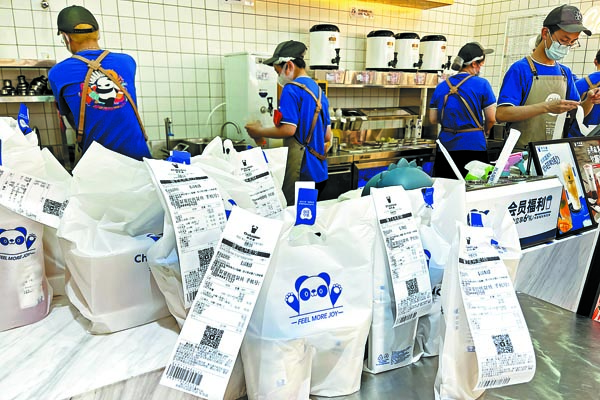

Roots of the drink
A report on the high-quality development of new-style tea drinks in China in 2022, which was released in December by the Tea Research Institute, Chinese Academy of Agricultural Sciences, shows that, last year, the market size of new tea drinks exceeded 290 billion yuan ($42.7 billion), a year-on-year increase of 5.1 percent.
According to the data by iiMedia Research, the scale of China's new-style tea market in 2025 will reach 374.9 billion yuan.
There were around 450,000 new-style tea stores across China in 2022 and a dozen major tea makers, which own over 1,000 stores across the country, such as Mixue Bingcheng, CoCo, Chabaidao and ALittle Tea.
Last year, the new-style tea drink industry purchased over 200,000 metric tons of raw tea material, which directly drove over 10 billion yuan of added value to the primary tea industry.
Jiang Renhua, head of the Tea Research Institute, says a batch of new-style tea beverage brands have rapidly developed in the past couple of years.
He suggests that these brands work on the supply side of the tea industry to push traditional tea drinking to adopt a new direction to fulfill the diversified needs of younger customers.
"Their bold innovation and practice has injected new vitality and added new charm to traditional Chinese tea with innovative products and a fashionable consumption experience," Jiang says.
According to the report, around 47 percent of the post-1990 generation say they now know more about traditional tea as a result of shopping for the new-style tea drinks, while 45 percent know the different categories of tea.
Fifty-five percent say that they feel the charm of Chinese tea culture, while 46 percent say they have a "great interest" in traditional culture.
In November, traditional tea processing techniques and their associated social practices in China were added to UNESCO's representative list of Intangible Cultural Heritage of humanity.
Shen Dongmei, a researcher focused on tea culture from the Chinese Academy of Social Sciences, thinks the successful bid for China's traditional tea processing techniques, and the products associated social practices, will boost both the traditional and new-style tea markets.
For young customers, new tea products can provide opportunities to learn more about tea culture and they may develop a greater interest in traditional tea drinking, especially because there is a trend toward healthier choices, with less sugar and lower calories, Shen says.
Shen thinks that traditional culture can bind well with modern trends. "Young customers are always looking for something new, and through constantly consuming new-style tea drinks, they may want to learn about the history and culture behind the tea," she says.
In Shen's mind, coffee drinking is more about office culture, while tea drinking suits a greater number of scenarios. She notes that it's suitable for both solo and group consumption, and can be drunk lightly or enjoyed for a whole afternoon.
"Tea has more cultural features. Young people enjoying new tea drinks is a reflection of cultural confidence," she says.